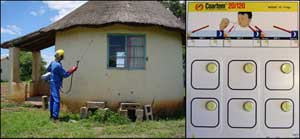KwaZulu-Natal’s successful fight against malaria

Caption: Mosquito control and ACT are both likely contributors to the reduction of malaria in KwaZulu¡VNatal. (Photo: Karen Barnes and Atis Muelenbachs)
A new drug is demonstrating impressive results in the fight against malaria, according to a forthcoming paper in the open access journal PLoS Medicine. The study of a malaria control program in South Africa shows how hospital admissions for malaria were dramatically reduced following the introduction of an antimalarial combination called artemether-lumefantrine (AL) and the partial reintroduction of the insecticide DDT. The malaria epidemic has been particularly resurgent in recent years as the parasites transmitting the disease have developed resistance to many of the existing drugs. Approximately a million people are killed by malaria every year, predominantly in Africa. KwaZulu-Natal was the first Ministry of Health in Africa to introduce an artemisinin-based combination therapy (ACT) malaria treatment policy.
Karen Barnes and colleagues describe and evaluate the new measures against malaria put in place in the KwaZulu-Natal province, where cases had risen fifteen-fold during the 1990s. AL was introduced to the area in 2000 alongside an intensified effort to control mosquitoes with insecticides. Reviewing data from four health care facilities representative of the province, the researchers found that admissions for malaria had declined by 89% in the year following the changes. By 2003 the decline in malaria had been sustained throughout the province: outpatient cases fell by 99% and malaria-related deaths had decreased by 97%.
The authors are keen to stress the vital importance of a health care infrastructure that can deliver prompt diagnosis, as well as perceptions within the community that treatment for malaria should be sought urgently and completed at public-health care facilities. These favourable factors combined with better control of mosquitoes, including the use of DDT for reed and mud homesteads, maximized the benefits of AL treatment in Africa. It makes KwaZulu-Natal an encouraging example of how to combat malaria following its dramatic and deadly increase.
In an accompanying Perspective, Patrick Duffy (of the Seattle Biomedical Research Institute) and Thehonest Mutabingwa (of the National Institute for Medical Research in Tanzania) highlight lessons learned from the “notable success” in KwaZulu-Natal “amid the dire statistics showing a deadly resurgence of malaria.”
Media Contact
More Information:
http://www.plos.orgAll latest news from the category: Health and Medicine
This subject area encompasses research and studies in the field of human medicine.
Among the wide-ranging list of topics covered here are anesthesiology, anatomy, surgery, human genetics, hygiene and environmental medicine, internal medicine, neurology, pharmacology, physiology, urology and dental medicine.
Newest articles

A universal framework for spatial biology
SpatialData is a freely accessible tool to unify and integrate data from different omics technologies accounting for spatial information, which can provide holistic insights into health and disease. Biological processes…

How complex biological processes arise
A $20 million grant from the U.S. National Science Foundation (NSF) will support the establishment and operation of the National Synthesis Center for Emergence in the Molecular and Cellular Sciences (NCEMS) at…

Airborne single-photon lidar system achieves high-resolution 3D imaging
Compact, low-power system opens doors for photon-efficient drone and satellite-based environmental monitoring and mapping. Researchers have developed a compact and lightweight single-photon airborne lidar system that can acquire high-resolution 3D…





















